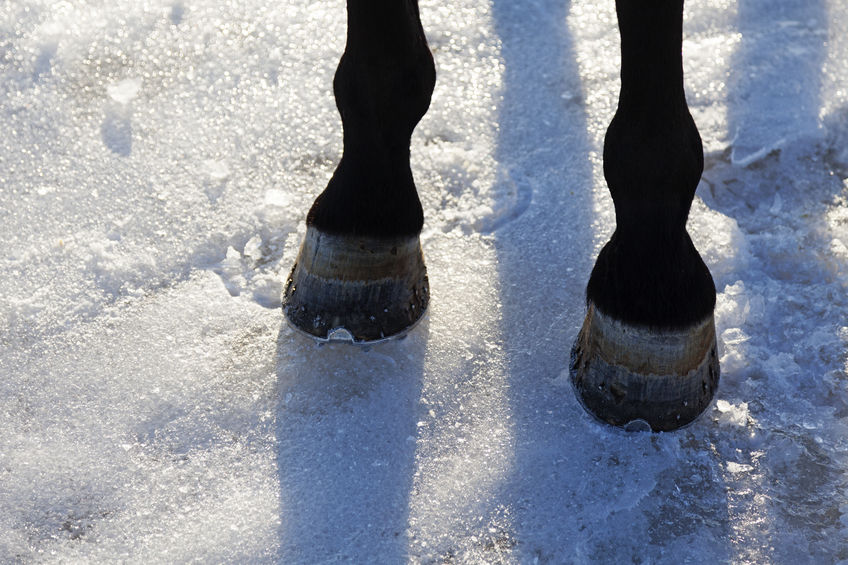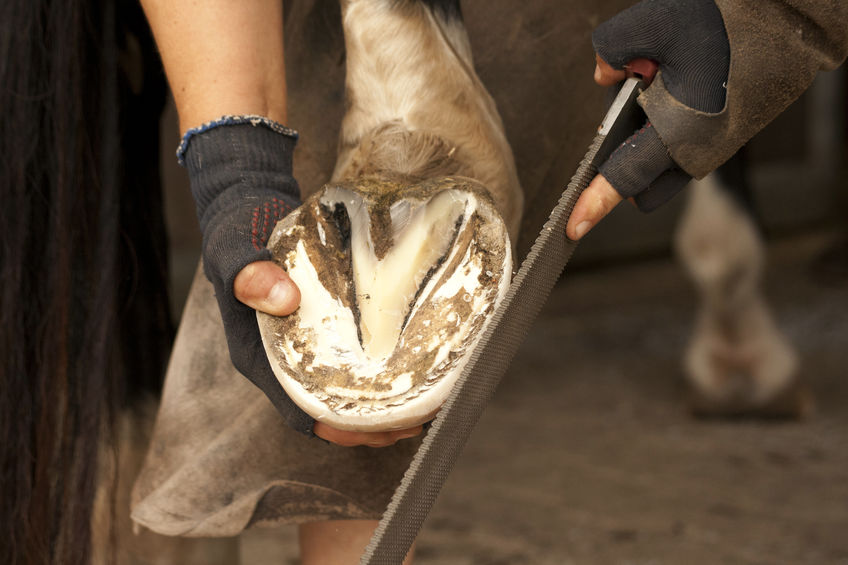 In winter, everybody wants to curl up by the fireplace to escape the blustery winds, biting chill, and wet snowfall waiting for them outside. Unfortunately for horse owners, that’s not always an option! No matter how unkind winter weather conditions may be, you need to get out to your horse everyday to ensure they have everything they need to stay healthy, safe, warm, and comfortable through this challenging season.
In winter, everybody wants to curl up by the fireplace to escape the blustery winds, biting chill, and wet snowfall waiting for them outside. Unfortunately for horse owners, that’s not always an option! No matter how unkind winter weather conditions may be, you need to get out to your horse everyday to ensure they have everything they need to stay healthy, safe, warm, and comfortable through this challenging season.
One responsibility that can sometimes fall through the cracks during your winter routine is hoof care. Just because you and your horse aren’t as active this season, doesn’t mean their hooves aren’t still vulnerable. Use our helpful guide below to learn about some of the most common winter hoof problems to look for, how to treat them, and how to prevent them!
1) Thrush
What It Is
Thrush is a bacterial (or sometimes fungal) infection that eats away at the tissue of the frog of a horse’s hoof. If your horse is infected, the tissue on their hoof will be black, oozing, and likely have a rotten odor.
How to Treat It
If thrush is not treated, it can spread deeper into the more sensitive tissue of the hoof and lead to lameness. If you notice signs of thrush on your horse, contact your vet or farrier promptly. They will clean out the hoof to remove as much of the dead/decaying tissue as possible, pare down to the healthy tissue to facilitate airflow to any damaged tissue remaining, and use an antibacterial product to kill the infection.
How to Prevent It
Regular hoof cleaning and inspection is the best way to prevent thrush from developing. You’ll also want to maintain a clean, dry stall, as moisture (especially from snow in the winter) makes hooves more susceptible to infection.
2) Bruising
What It Is
Hard impact on a horse’s hoof sole can damage the blood vessels underneath, leading to inflammation, pressure, bleeding, and/or sensitivity and pain. Bruising may or may not be visible on your horse’s hoof. If you can see a bruise, it will appear as a dark spot with a crack. Or, you may notice your horse favoring one foot or acting lame.
How to Treat It
If you suspect hoof bruising, a vet can pinpoint the soreness area with a hoof tester. They will then pare down the sole in that area to reduce pressure and ease discomfort. A protective bandage should then be applied and your horse should rest for a few days.
How to Prevent It
Regular cleaning and grooming of your horse’s hooves help to keep them strong and less prone to bruising. Try to avoid uneven or stony ground that can be rough on their soles. Also, do not force your horse to walk or ride on frozen ground if they seem reluctant. Shoes with protective pads can sometimes be helpful as well.
3) Abscesses
What It Is
The constant oscillation between wet and dry weather that winter often yields causes your horse’s hooves to repeatedly expand and contract, making them more vulnerable to developing abscesses. An abscess grows when bacteria gets trapped underneath the sole, multiplies, and forms a bubble of pus. Untreated bruising can also result in an abscess.
These growths can range from mildly sore for your horse to extremely painful. Look for sudden lameness, visible growths, and feel for hot spots to identify an abscess.
How to Treat It
To heal an abscess, it must be drained and thoroughly cleaned to prevent infection. Your vet can do this for you. You can also help drain the abscess slowly with Epsom salt-foot soaks in warm water.
How to Prevent It
When paring your horse’s hooves, leave enough thickness for adequate sole protection. Protective shoes can also be helpful in preventing hoof damage that can result in an abscess. Be sure to inspect daily for signs of bruising or other damage, so it can be treated before an abscess forms.
4) Snow Accumulation
What It Is
If you shoe your horse in the winter, snow can pack inside, freeze upon contact with the cold metal, and form snow and ice balls in the center of the shoe. Walking on “snowballs” can obviously lead to tripping, soreness, and injury (such as bruising and abscesses).
How to Treat It
Snow that has accumulated in your horse’s shoes must be removed physically. Soaking them in warm water can help melt packed ice.
How to Prevent It
One option for preventing snow accumulation is to leave your horse barefoot for the winter. If you prefer not to do that, you should consider using anti-snowball pads. These go between the sole and the shoe to push out snow and ice.
Just like you, your horse needs a safe place where they can get warm and comfortable when wintry weather and freezing temperatures come around. Deer Creek Structures has you covered with top-quality run-in sheds, portable shedrow barns, and aisle barns for your property! Built with the health and happiness of your horse in mind, and the finest American craftsmanship, our structures will be around to protect your horse for a lifetime.
Contact us today to see what structures we have in stock or to get started on a custom barn!

